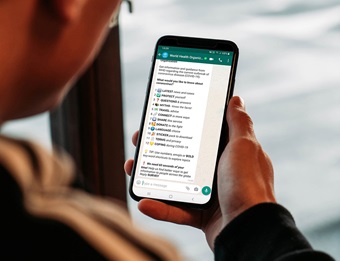
Creating new tools and channels to amplify health messages
A key element of WHO’s digital response has been working with technology partners to reach people through new tools and channels on trusted platforms. By meeting users on their existing digital journey, WHO can communicate with audiences who may
not actively seek public health advice from approved sources.
WHO Health Alert Chatbots
Early in the pandemic, messaging platforms such as WhatsApp, Facebook Messenger and Viber created the WHO Health Alert Chatbot, which provides millions of people with the latest news and information on how to protect yourself and others from COVID-19,
now available in over 19 languages. The WhatsApp chatbot alone has reached over 13.5 million people.
Access to health information through chatbots has been especially critical in low-income countries and fragile states where health systems are often too fractured or strained to meet all community needs during outbreaks.

Telecommunications Partnerships
In early 2021, WHO also collaborated with Out There Impact and telecommunications partners to reach 300 million people with critical preventative COVID-19 information through mobile chat bots using rich media. Over fifteen mobile operator partners are involved across Europe, Africa and Asia.
Public Health Information Free of Data Charges
In another effort to democratize health information, WHO partnered with Facebook Free Basics to make science-based health information on COVID-19 available free of data charges on multiple carriers. The partnership has reached more than 1.5 million of the most vulnerable people on the Internet.
World’s first virtual health worker using AI
Recognizing the power of artificial intelligence (AI), WHO created the world’s first virtual health worker, Florence, using AI technology to help the world's 1.3 billion tobacco users quit smoking. Florence uses AI to dispel myths about COVID-19 and smoking and helps people develop a personalized plan to quit tobacco. Around 60% of tobacco users worldwide say they want to quit, yet only 30% of them have access to the tools they need to take action.



